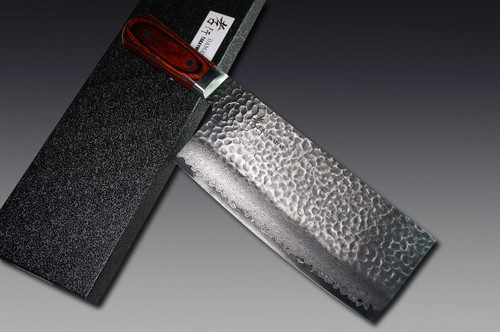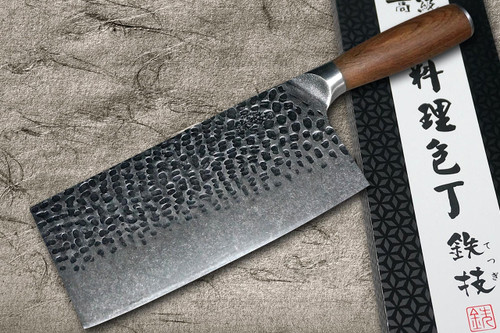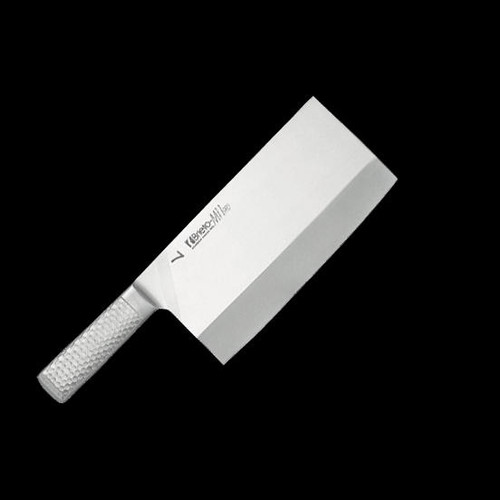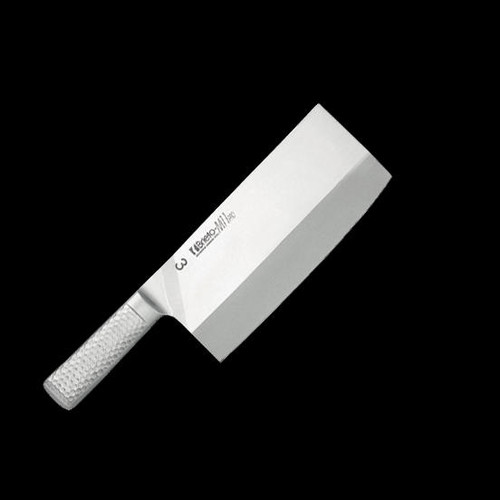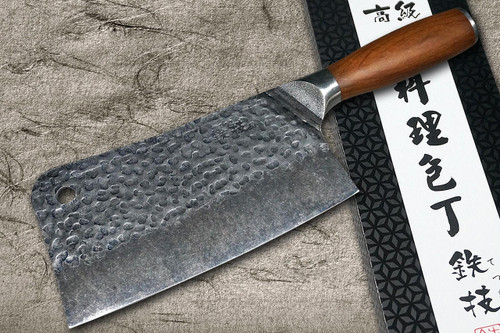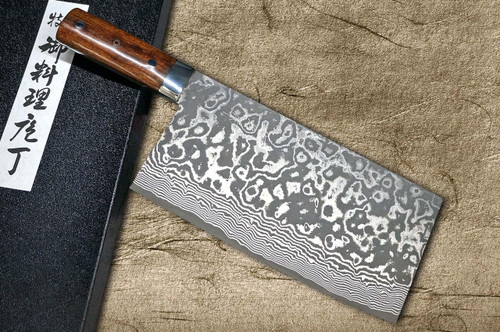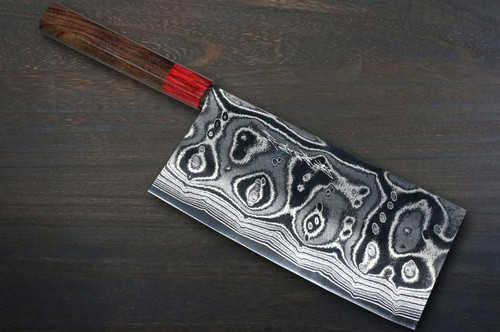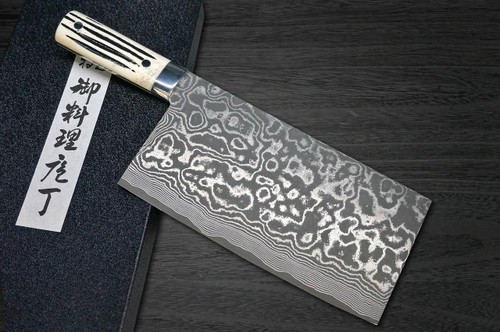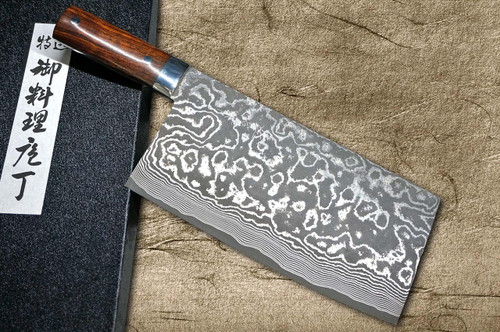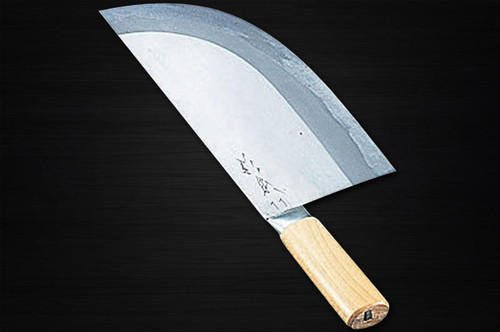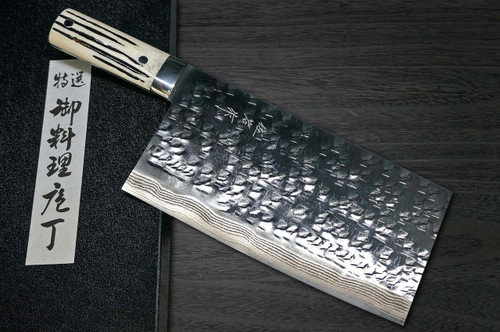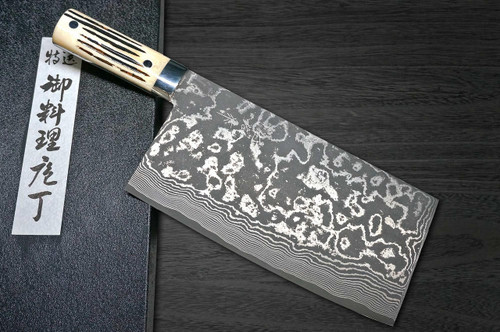Cleaver(Chinese Knife) Selections
Professionals' Picks! Top 5 Recommended Chinese Knives and How to Choose Without Regret
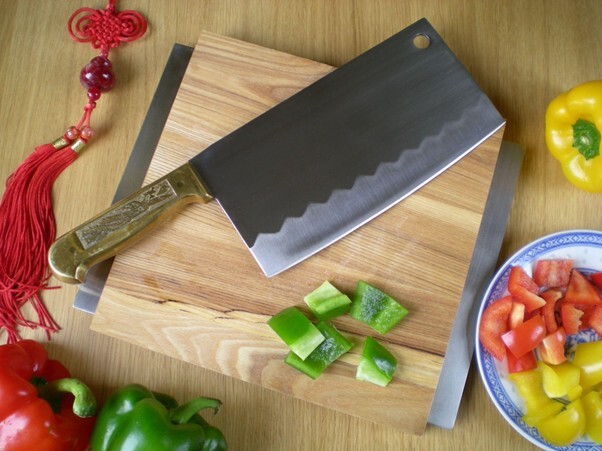
"Which Chinese cleaver should I choose?"
"I'm not sure if I really need a Chinese knife…"
Do you have these concerns?
A Chinese cleaver helps streamline your cooking. Knowing how to choose the right one can shorten prep time and your culinary repertoire.
Therefore, this article explains how to choose and recommends products for those considering purchasing a Chinese cleaver. Please read to the end for reference in making your purchase decision and selecting a product.
Chinese Cleaver (Chinese Knife) Advantages/Disadvantages
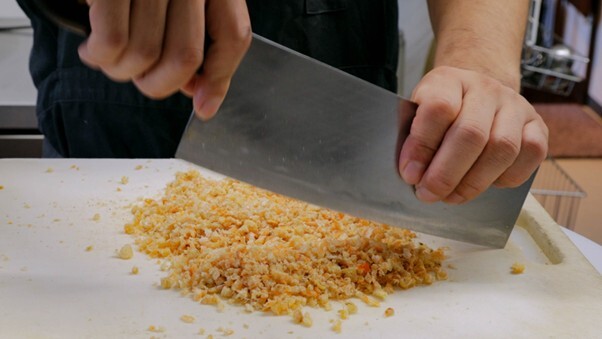
B efore purchasing a Chinese cleaver, it's important to thoroughly understand its advantages and disadvantages. Chinese cleavers have the following characteristics:
Advantages- Advantage 1: Utilizes its weight for clean, swift cuts
- Advantage 2: Can chop through bones
- Advantage 3: Wide blade makes scooping ingredients easy
- Advantage 4: Versatile use with just one knife
- Disadvantage 1: Hands tire easily with prolonged use
- Disadvantage 2: Not suitable for detailed work
- Disadvantage 3: Difficult for beginners to handle
We'll explain each in detail.
Advantage 1: Utilizes its weight for clean, swift cuts
The greatest advantage of a Chinese cleaver is its ability to cut ingredients cleanly in one swift motion using its weight.
Compared to standard knives, Chinese cleavers are heavier, allowing you to leverage that weight for efficient cutting. For example, when cutting hard vegetables or thick meat, you can achieve clean cuts using just the knife's weight without exerting much force.
This characteristic significantly reduces cooking time and minimizes fatigue, making it a major appeal of Chinese cleavers.
Benefit 2: Can chop through bones
Another important advantage is the Chinese cleaver's strength, allowing it to chop through bones.
Its thick blade and sturdy construction allow it to smash through chicken bones and fish bones. It excels at processing bone-in ingredients like chopping chicken into chunks or cutting fish into fillets.
Tasks like cutting through bones, which are difficult with a regular knife, can be done safely and efficiently with a Chinese cleaver.
Benefit 3: Wide Blade Makes Scooping Ingredients Easy
The wide blade surface of a Chinese cleaver offers the practical advantage of making it easy to scoop ingredients.
The large blade surface allows you to transfer cut ingredients directly onto the blade and into pots or dishes. For example, you can use the blade to move minced vegetables or chopped meat into a frying pan all at once, making cooking smoother.
This feature eliminates the need to manually gather ingredients from the cutting board, enabling hygienic and efficient cooking.
Benefit 4: Versatile with just one knife
A major advantage of the Chinese cleaver is its versatility, handling a wide range of tasks with a single knife.
It handles diverse tasks like slicing, chopping, pounding, and scooping. For example, it can slice vegetables, pound meat thin, crush garlic, and scoop ingredients for transfer.
Since you don't need to use multiple knives, it saves kitchen space and reduces the number of items to wash.
Disadvantage 1: Hands tire easily with prolonged use
A drawback of the Chinese cleaver is that it can cause hand fatigue with prolonged use.
Its weight places strain on the wrist and arm during continuous use. For instance, chopping large quantities of vegetables or performing detailed tasks for extended periods can lead to accumulated fatigue.
Particularly for those with less strength or older individuals, adjustments to usage time or other considerations are necessary.
Disadvantage 2: Not well-suited for detailed work
A disadvantage of Chinese cleavers is that their large, thick blades make them unsuitable for detailed work.
It struggles with delicate tasks like decorative cutting, peeling, and handling small ingredients. For example, tasks like blanching tomatoes, peeling fruit, or removing small fish bones are better suited to smaller, specialized knives.
When preparing dishes requiring precision work, it is necessary to use other knives for specific tasks.
Disadvantage 3: Difficult for Beginners to Handle
A disadvantage for beginners is that Chinese cleavers can be difficult to handle.
Its weight and large blade can make it difficult to control effectively until you become accustomed to it. For instance, it often takes time to master the appropriate pressure and angle adjustments, leading to initial struggles with cutting cleanly.
To use it safely, you need time to learn the correct grip and technique.
How to Choose a Chinese Cleaver (Chinese Knife)

When selecting a Chinese cleaver, it's crucial to choose one suitable for your intended use and frequency. The five key points for selecting a Chinese cleaver are as follows:
- Choose by Blade Thickness
- Choose by Blade Length (Blade Length)
- Choose by Material (Steel/Stainless Steel)
- Select by Weight and Balance
- Select based on handle shape
We'll explain each selection method in detail at.
Choosing by Blade Thickness
When selecting a Chinese cleaver, blade thickness is one of the most important factors.
The thickness of the blade significantly affects its purpose and sharpness, so you need to choose one suited to your cooking style. Thin blades (2–- 3mm) are ideal for julienning vegetables and preparing sashimi. Medium-thick blades (4–- 5mm) are versatile for general home cooking. Thick blades (6mm or more) are best for cutting through bones and handling tough ingredients.
For beginners, we recommend starting with the versatile medium-thick blade. A blade that is too thick makes detailed work difficult, while one that is too thin cannot handle cutting through bones.
| Blade Thickness | Recommended Uses | Characteristics |
|---|---|---|
| Thin Blade (2 – 3mm) | Julienned vegetables, sashimi | Sharp cutting edge, ideal for delicate work |
| Medium-Thick Blade (2 – 3mm) | General home cooking | Well-balanced, ideal for beginners |
| Thick blade (6mm or more) | Bone cutting, hard ingredients | High durability, powerful cutting |
Selecting by Blade Length (Blade Length)
Selecting the blade length is crucial based on the size of ingredients and cooking volume.
Generally, a blade length of 20–22 cm is considered the most user-friendly size for home use. For example, when cutting a whole cabbage, a blade that is too short requires multiple passes with the knife, while one that is too long becomes unwieldy.
While larger sizes of 25– 30cm are used commercially, considering typical household cutting board and sink sizes, 20– 22cm is more practical. For first-time buyers of a Chinese cleaver, starting with this standard size is recommended.
Choosing by Material (Steel/Stainless Steel)
When selecting the material for a Chinese cleaver, it's important to balance the effort required for maintenance with the sharpness of the blade.
Carbon steel Chinese knives offer sharp cutting performance and are easy to sharpen, but they rust easily and require daily care. Stainless steel knives, on the other hand, are rust-resistant and low-maintenance, but they have slightly inferior cutting performance compared to carbon steel and are harder to sharpen.
If you cook frequently and can handle regular maintenance, choose carbon steel. For those seeking convenience or beginners, stainless steel is a good choice. Recently, composite materials combining the best of both carbon steel and stainless steel have also grown in popularity.
Choosing by Weight and Balance
The weight and balance of a Chinese cleaver are crucial factors directly affecting ease of use.
Typical Chinese cleavers weigh around 300–- 500g. Too heavy strains the wrist, while too light feels insufficient for cutting ingredients. For example, women or seniors may find lighter options under 350g easier to handle, while stronger men around might prefer heavier ones 400– 500g.
The weight balance between the blade and handle is also crucial. Knives with the center of gravity toward the blade offer greater cutting power, while those weighted toward the handle provide better maneuverability. We recommend actually holding the knife to check its weight and balance before purchasing.
Choosing by Handle Shape
Handle shape significantly impacts fatigue during prolonged use and safety.
Chinese cleaver handles come in wood, resin, or metal, each with distinct characteristics. Wood handles feel comfortable and are slip-resistant, but they are vulnerable to moisture and require regular maintenance. Resin handles are hygienic and easy to care for, but they can become slippery with prolonged use.
Grip comfort is also crucial; selecting a handle thickness and shape that fits your hand size is important. Octagonal or oval handles are considered easy to grip and less tiring. If possible, try holding them in person and choose one that fits your hand well.
Care Instructions for Chinese Cleaver
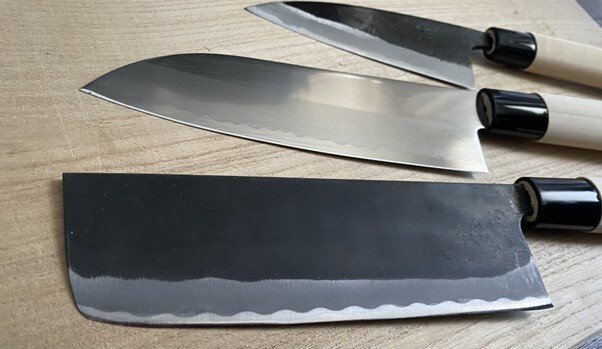
Proper care is essential for the long-term use of a Chinese cleaver. Appropriate maintenance helps maintain sharpness and prevents rust and deterioration.
Maintain your Chinese knife with these 5 steps:
- STEP1: Rinse with water immediately after use
- STEP2: Dry it immediately
- STEP3: Store in a well-ventilated area
- STEP4: Sharpen regularly with a whetstone
- STEP5: Apply oil once a month (for steel blades only)
Let's go through each step.
STEP1: Wash with water immediately after use
It's crucial to wash your Chinese cleaver with water immediately after use.
Leaving food residue or seasonings on the blade can cause rust and corrosion. Wash both sides of the blade with a neutral detergent and the soft side of a sponge, then thoroughly rinse off the detergent under running water.
Do not use abrasive detergents or hard scrubbing brushes, as they will damage the blade. Be especially thorough when washing after cutting salty or acidic ingredients.
STEP 2: Dry Immediately
Thoroughly drying the knife after washing is fundamental to rust prevention.
Leaving water droplets makes rust more likely to form. Steel Chinese cleavers are especially sensitive to moisture and can rust quickly .
Use a clean, dry cloth to carefully wipe the blade surface, the junction between the blade and handle, and the handle itself. When wiping, pay attention to the blade's orientation and proceed carefully to avoid injury.
STEP3: Store in a well-ventilated location.
After wiping away moisture, store in a well-ventilated location.
In humid locations or sealed drawers, residual moisture can easily cause rust. Avoid storage under sinks or in high-humidity drawers.
Ideal storage is in a knife block or magnetic holder. Store where the blade does not touch other utensils and air can circulate.
STEP 4: Sharpen regularly with a whetstone
Regular sharpening is essential to maintain sharpness.
Depending on usage frequency, sharpening about once or twice a month is recommended. Dull blades require extra force, increasing the risk of injury.
Use a medium-grit whetstone (1000-3000 grit) and maintain a consistent blade angle while sharpening. If unsure how to sharpen, use a professional sharpening service. Always wipe off moisture after sharpening.
STEP 5: Apply Oil Once a Month (Steel Only)
For steel Chinese knives, prevent rust by applying oil about once a month.
Applying a thin layer of cooking oil protects the blade from moisture in the air. Ensure the blade is completely clean and dry beforehand.
Apply a small amount of oil to a clean cloth and spread it thinly and evenly over the entire blade. Be careful not to apply too much, as excess oil attracts dust. Stainless steel knives do not require this step; simply wipe them lightly before use.
The Difference Between Cleaver and Chinese Knife
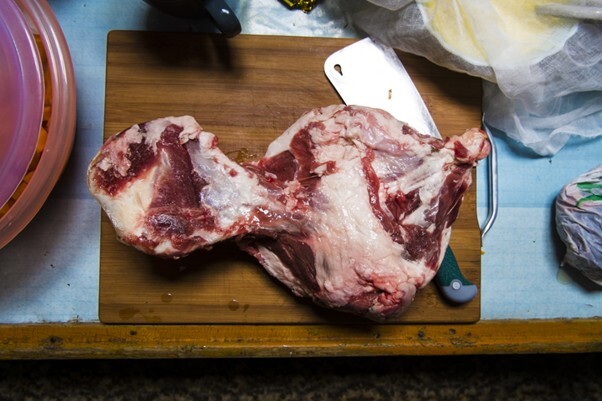
Both "Cleaver" and "Chinese Knife" refer to the Chinese kitchen knife in English, but there are differences in their recognition and uses.
| Item | Cleaver | Chinese Knife |
|---|---|---|
| Primary Uses | Bone cutting, meat tenderizing | All-purpose cooking (cutting, chopping, tenderizing, scooping) |
| Perception in the West | Meat-cutting tool | All-purpose Chinese kitchen knife |
| Target Ingredients | Primarily meat and bones | Vegetables, meat, and fish in general |
| Blade Characteristics | Thick and heavy | Thin to thick blades depending on use |
In Japan, it is popularly known as the "Chinese knife" and is used more as a versatile Chinese knife rather than a dedicated cleaver for cutting bones.
Both terms are now used interchangeably to refer to Chinese knives, but it's important to check the product's features and intended use when purchasing.
Top-Selling (Cleavers - Chinese Knife)

Based on actual sales data, we present a ranking of popular Chinese knives.
Use this as a reference to choose from five products with different price ranges and features, finding one that fits your needs and budget.
1st : Sakai Takayuki 33-Layer Damascus Steel
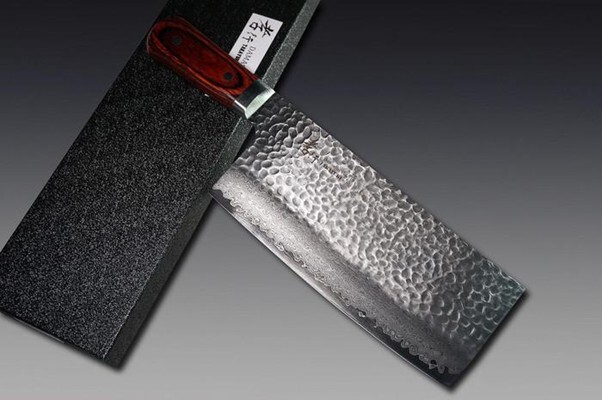
The most popular choice is this premium Chinese knife made with 33-layer Damascus steel. It uses VG10 alloy as its core, achieving an exceptionally hard blade with a hardness of HRC60. With a blade length of 195mm and a weight of 350g, it offers a manageable size, while the mahogany handle adds a beautiful aesthetic. Hand-sharpened, it delivers exceptional sharpness right out of the box. This exceptional piece is widely favored by everyone from professional chefs to home cooks.
【Recommended for】
- Those seeking the highest quality sharpness and beautiful appearance
- Those seeking a premium knife built to last
Product Page: HOCHO KNIFE|Sakai Takayuki 33-Layer VG10 Damascus Steel Hammered Finish Japanese Chef's Knife 195mm
2nd : Keiichi Fujii AUS10 Nickel Damascus Chinese Cooking Knife 200mm with Red-Ring Rosewood Handle
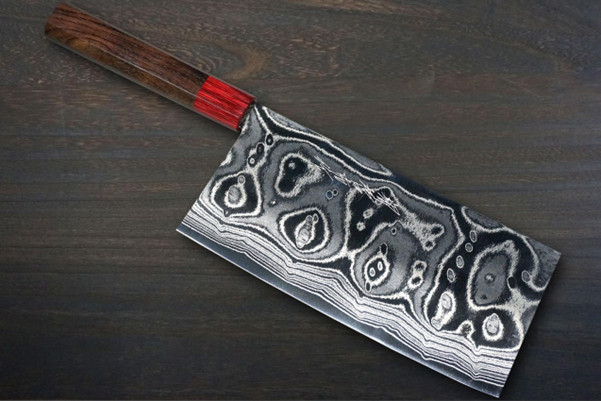
Ranked 2nd is Fujii’s Chinese chef's knife featuring a beautiful finish. Crafted from AUS10 Nickel Damascus feature Unique Suminagashi Damascus-patterned blades with a core of AUS10 stainless steel. The blade provides excellent rust resistance and a long-lasting edge as well as its beautifulness. The handles on these knives are made Octagonal-shaped Red Sandalwood with Plywood Bolster for beauty and durability. Easy to use for both professional and home kitchens, it's a popular choice offering great value.
【Recommended for】
- Those prioritizing a balance of design, quality and price
- Those wanting a knife for both professional and home use
Product Page: HOCHO KNIFE|Keiichi Fujii AUS10 Nickel Damascus Chinese Cooking Knife 200mm with Red-Ring Rosewood Handle
3rd : Sugimoto White Steel Japanese Knife
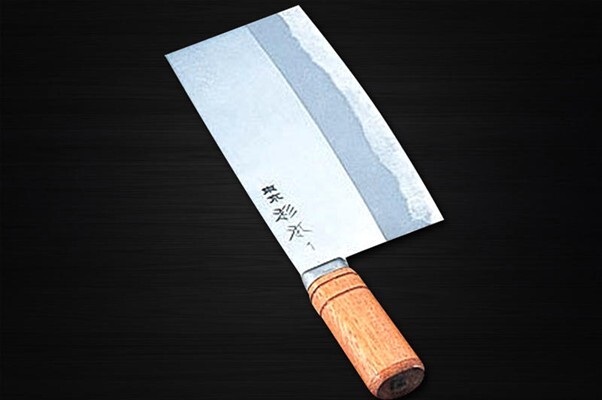
This authentic Chinese chef's knife, crafted from traditional white steel (high-carbon steel), ranks third. It features a generously sized 220mm blade length and a well-balanced design weighing 370g. White steel is known for its sharp cutting edge and ease of sharpening. This product, showcasing traditional Japanese knife-making techniques, is especially popular among those with a craftsman's spirit.
【Recommended for】
Those seeking a traditional Japanese knife, serious enthusiasts who enjoy sharpening and maintenance
Product Page: HOCHO KNIFE|Sugimoto White Steel Japanese Knife Chinese Chef's Knife 220x95mm [#1 - 4001]
4th : Takeshi Saji R2(SG2) Black Damascus Chinese Cooking Knife 220mm with Desert Ironwood Handle
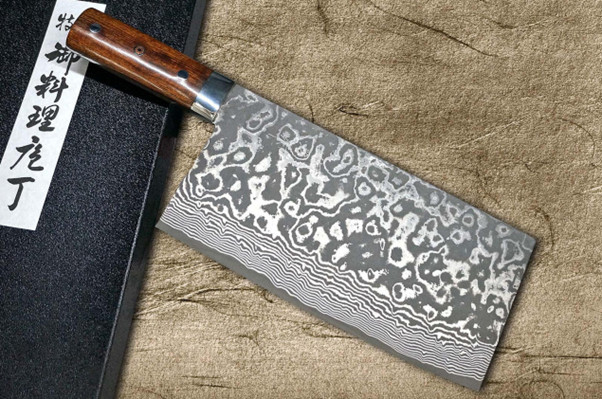
Ranked 4th famous Takeshi Saji’s Chinese chef's knife, featuring a unique beautiful finish. Crafted from Damascus-patterned blades with a core of SG2 (Super Gold 2 or R2) Micro Carbide Powder Stainless Steel. The blade provides excellent rust resistance and a long-lasting edge as well as its beautifulness. Easy to use for both professional and home kitchens, it's a popular choice offering great value.
【Recommended for】
- Those prioritizing a balance of design, quality and price
- Those wanting a knife for both professional and home use
Product Page: HOCHO KNIFE|Takeshi Saji R2(SG2) Black Damascus Chinese Cooking Knife 220mm with Desert Ironwood Handle
5th : Brieto-M11PRO Stainless
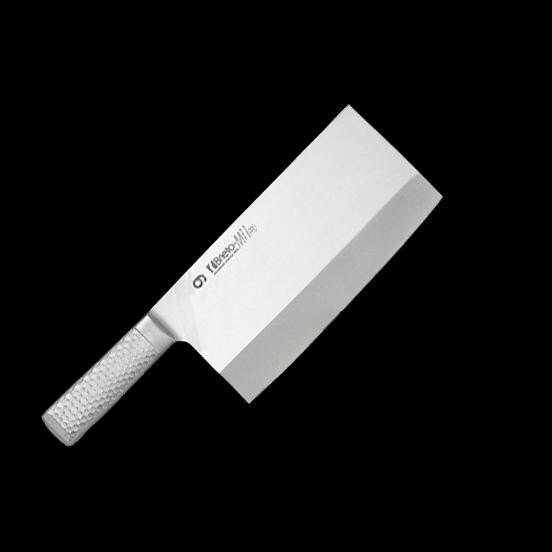
Ranked 5th is a professional-grade Chinese knife made by Kataoka Seisakusho. Made from premium molybdenum vanadium stainless steel, it features rust resistance and hygienic properties. A three-stage heat treatment process—quenching at 1050°C, subzero treatment at -73°C, and tempering—achieves exceptional hardness. The 18-8 stainless steel handle offers a comfortable grip and boasts decades of durability. Designed for professional kitchens, this product prioritizes practicality.
【Recommended for】
- Professionals prioritizing hygiene
- Those seeking long-term commercial use
Product Page: HOCHO KNIFE|Brieto-M11PRO MV Stainless Japanese Chef's Chinese Cooking Knife (B)220x110mm
Knives Often Compared to Chinese Knives
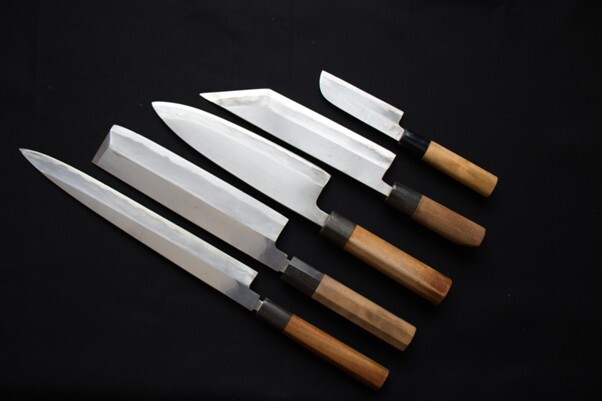
When selecting a Chinese cleaver, understanding its differences from other knives is crucial. Three types of knives are particularly often compared.
- Utility knife
- Chef's Knife
- Petty Knife
We'll organize the characteristics of each in a table and explain them to help you make the right choice.
| Types of Knives | Blade Characteristics | Primary Uses | Ease of Handling | Price Range |
|---|---|---|---|---|
| Chinese Chef's Knife | Large, thick, and square | Cutting, chopping, scooping, boning | Somewhat difficult | USD60 and the above |
| Santoku knife | Medium-sized and lightweight | Basic cutting of vegetables, meat, and fish | Easy | USD45 and the above |
| Chef's Knife | Large size with a sharp tip | Meat preparation and vegetable cutting | Standard | USD50 and the above |
| Petty knife | Small and lightweight | Peeling, decorative cutting, and detailed work | Easy | USD35 and the above |
Difference from a Santoku Knife
The biggest difference between a Chinese cleaver and a Santoku knife is size and versatility.
The Santoku knife is the most commonly used all-purpose knife in Japanese households, characterized by its light weight and ease of handling. In contrast, the Chinese cleaver is heavier and suited for tasks like cutting through bones and large-scale cooking. While a Chinese cleaver can handle tasks difficult for a Santoku knife, the Santoku is better suited for detailed work.
For beginners, we recommend the Santoku knife; for those aiming for serious cooking, the Chinese cleaver is recommended.
Difference from a Chef's Knife
Both the Chinese cleaver and the gyuto are large knives, but their design philosophies differ.
The chef's knife has a pointed tip, making it ideal for precise cutting tasks. It excels at cutting through meat fibers and slicing thinly, but it is not well-suited for cutting through bones. The Chinese cleaver features a square, thick blade tip, excelling at powerful tasks and offering great versatility.
For primarily Western cuisine, choose a chef's knife; for Chinese cuisine or versatile use, a Chinese cleaver is more suitable.
Differences from a Petty Knife
The Chinese cleaver and the petty knife are polar opposites in size and purpose.
The petty knife is small and lightweight, specializing in delicate tasks like peeling fruit and decorative cutting. The Chinese cleaver is large and excels at handling big ingredients and tasks requiring force.
In actual cooking, it's effective to use a Chinese cleaver for prep work and a paring knife for finishing tasks.




